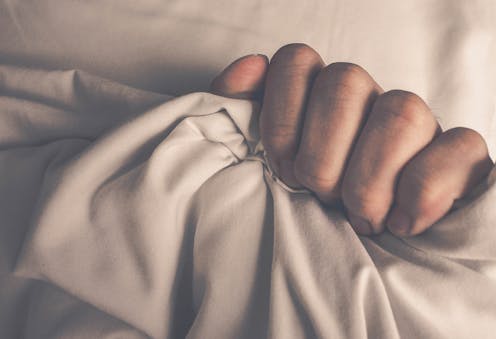4 things about female orgasms researchers actually study
- Written by Jane Chalmers, Senior Lecturer in Pain Sciences, University of South Australia

Cardi B’s song WAP and the Netflix show Sex Education place female orgasms on centre stage in popular culture.
But female orgasms are also the subject of serious academic research.
Here’s a snapshot of what research tells us about female orgasms, what we don’t know, and what researchers want to find out.
Read more: From reproducers to 'flutters' to 'sluts': tracing attitudes to women's pleasure in Australia
1. When women orgasm, what actually happens?
When women orgasm, their pelvic floor muscles contract rhythmically and involuntarily. These contractions are thought to help move blood out of erect tissues of the clitoris and vulva, allowing them to return to their usual flaccid (floppy) state.
During sexual arousal and orgasm, women’s heart rate, respiration rate and blood pressure also rise.
Read more: 'Is it normal for girls to masturbate?'
Levels of oxytocin, known as the “love hormone”, increase during sexual arousal and are thought to peak during orgasm.
The areas of the brain associated with dopamine, the “happy hormone”, are activated in men and women.
And in women, other areas of the brain are activated further during sexual arousal and peak with orgasm. These include those associated with emotions, the integration of sensory information and emotions, higher-level thinking, and motor areas associated with pelvic floor muscles.
The “right angular gyrus” part of the brain may also be linked with an altered state of consciousness some women say they experience when they orgasm.
Read more: Health Check: does the 'G-spot' exist?
What is trickier to determine is how the body and brain relate. We know the frequency and intensity of female orgasms depends on a range of complex psychosocial factors, including a woman’s sexual desires, self-esteem, openness of sexual communication with their partner, and general mental health.
2. Not all women orgasm. Is that a problem?
Orgasms are not a big deal for all women, and that’s completely normal.
And 21% of Australian women aged 20-64 say they cannot climax. From a simplistic biological viewpoint, anorgasmia (the inability to orgasm despite adequate sexual stimulation) is also not a problem. However, women with anorgasmia often report shame, inadequacy, anxiety, distress and detachment surrounding intercourse and orgasm.
These negative emotions might be related to the long history of suppression, and now celebration, of women’s sexual pleasure.
For many women, orgasms represent empowerment. Understandably, then, anorgasmia can leave women feeling as though there is something wrong with them. Some might fake orgasm, which around two-thirds report doing. This is usually to make them feel better about themselves, or to make their partners feel better.
Many women say they fake their orgasms, as portrayed in the classic movie When Harry Met Sally.More than 80% of women won’t orgasm from vaginal stimulation alone. So if anorgasmia is a problem, trying different types of stimulation might help, particularly clitoral stimulation.
When anorgasmia leads to negative feelings or gets in the way of forming or sustaining healthy sexual relationships, it becomes a problem. But certain websites, “sextech” (technology that aims to enhance female sexual experiences), and dedicated health professionals can help.
3. Can you over-orgasm?
No! While a survey run by an online dating site suggests 77% of women have had multiple orgasms, academic research suggests the figure is much lower, at around 14%.
Some women who have multiple orgasms report their second orgasm as the strongest, but ones after that become less intense.
Just make sure you have enough lubrication to last the distance, as prolonged stimulation without sufficient lubrication can lead to pain.
Around 50% of women in one study said they use vibrators to reach orgasm (or multiple orgasms). Some people say vibrators can decrease the sensitivity of the clitoris, making it harder for women to orgasm through clitoral stimulation that doesn’t involve vibration. However, most research finds any desensitisation is mild and transitory.
4. What use is it anyway?
Evolutionists tend to take three views on why the female orgasm has evolved: to increase the success of reproduction; to enhance pair-bonding between women and their sexual partner; or the one I consider the most likely, is that women’s orgasms do not serve any evolutionary purpose at all. They are simply a by-product of evolution, existing because the male and female genitals develop in a similar way as embryos, and only begin to differentiate at about six weeks’ gestation.
Just because women’s orgasms do not serve an evolutionary purpose, that doesn’t mean they aren’t important. Women’s orgasms are important because for many women, they contribute to healthy relationships and their sexual well-being.
Read more: Oh, oh, oh! The clitoris certainly gives pleasure. But does it also help women conceive?
What’s left to find out?
For a long time, we’ve assumed details about the female orgasm based on its male counterpart. And it’s only since 2011 that we’ve been able to map what happens in women’s brains during sexual stimulation. So there’s plenty about the female brain during orgasm we haven’t yet explored.
We’ve only recently learned about the true size and function of the clitoris. We’re also still debating whether the G-spot exists.
Women’s sexuality, desires, likes and dislikes are also incredibly varied. And in this article, we’ve only talked about, and included research with, cis-gendered females, people whose gender identity and expression matches the sex they were assigned at birth.
So we also need more research with gender-diverse people to better understand the complexity and diversity of orgasm and sexuality.
Whether science can explain all these differences in the complexity of the human being remains to be seen.
Authors: Jane Chalmers, Senior Lecturer in Pain Sciences, University of South Australia
Read more https://theconversation.com/4-things-about-female-orgasms-researchers-actually-study-151015



















